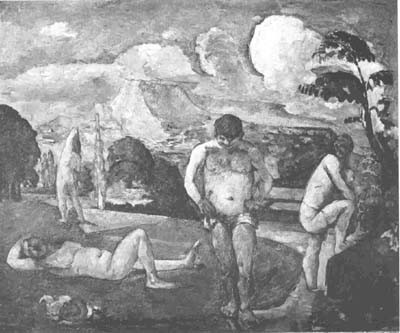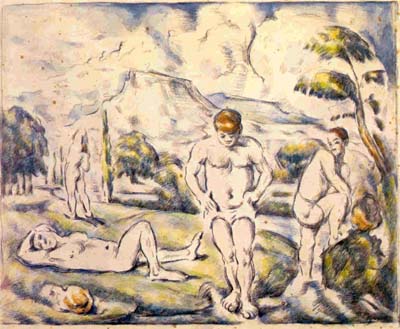
Bulletin 19, 1972
Home
Français
Introduction
History
Annual Index
Author &
Subject
Credits
Contact


Cézanne,
Vollard, and Lithography: The Ottawa Maquette for the "Large Bathers"
Colour Lithograph
by Douglas W. Druick
Résumé en français
Pages 1 | 2
| 3 | 4 |
5 | 6
| 7 | 8 |
9 | 10
| 11
12 | 13 |
14 | 15
| 16 | 17
| 18
*This article will not attempt an analysis of the meaning of
the Large Bathers, an undertaking which would entail a study
of the Bathers at Rest (fig. I) and related compositions of
the 1870s. Interpretation of Cézanne's "bather" compositions has been the object of several studies, the most notable of
which is Theodore Reff's "Cézanne's Bather with Out-stretched
Arms," Gazette des Beaux-Arts, vol. 59 (March 1962), pp.
173-190.
A black-and-white lithograph heightened with water-colour, the Large
Bathers (fig. 2) in the collection of the National Gallery of
Canada is one of a very small group of works executed by Cézanne in
the latter half of the 1890s when he was involved in the publishing
projects of the art dealer Ambroise Vollard. It was prepared by the
artist to serve as a maquette, or model, to guide the printer
Auguste Clot in the preparation of the colour lithograph (figs
3, 4). (1) Very little is known about the maquette in Ottawa or about
the four other watercolour and lithograph maquettes (figs 5, 6, 7,
12) which are attributed to Cézanne. Essential to their
understanding is a knowledge of the artist's lithographs themselves.
But the only works by the artist which come as close as the
maquettes to having been critically ignored are the black-and-white
lithographs used in their preparation and the colour prints for
which they were executed. Therefore an investigation of the Ottawa
maquette necessitates the prior study of two little-known but
intimately related aspects of the artist's oeuvre.*
Cézanne was not, it seems, very interested in print-making. Of the
five etchings (2) and three lithographs which constitute his entire
output of prints, none can be said to reflect a desire to explore
the possibilities of unfamiliar media. Rather, both the etchings and
the lithographs were in large part the result of special conditions under which they were executed. The artist's production of
etchings, all of which were done at Auvers during the summer and
autumn of 1873, can be directly related to the preoccupations of the
company in which he found himself. (3) Surrounded as he was by three
print enthusiasts - Pissarro, Dr Gachet, and Armand Guillaumin -
Cézanne
was coaxed into making prints. His reluctance to use the medium is
apparent from the fact that all five prints are basically
soft-ground etchings prepared by tracing completed sketches.
When, almost twenty-five years later, Cézanne again made
prints, the motivation was similarly related to a particular set
of circumstances: his association with Vollard and the latter's rôle
in the Print Revival of the nineties. It is in Cézanne's
relationship with his dealer that it is possible to discover why he
again became involved in print-making. The peculiar nature of
Vollard's activity within the current revival explains both the
medium of these later prints and the particular significance of the
lithograph and water-colour maquettes in the context of print-making during the last decade of the nineteenth century. A study of
the Ottawa maquette must, therefore, begin with a review of the
developments in the Print Revival and the rôle played by Vollard.
In 1895 Vollard, having just opened a gallery in the rue Lafitte,
decided to commission and publish original prints by important
contemporary artists. (4) The revival of interest in prints, and
particularly the vogue for colour lithography, was then at its
height. The generative force in the popularizing of original graphics had been the periodical
L'estampe
originale, (5) which had
disseminated prints by contemporary artists representative of a
variety of stylistic trends. published and directed by André Marty,
L'estampe originale had appeared as a series of nine fascicules,
or installments, issued quarterly beginning in March 1893. While
the publication included prints in various media, it had been
particularly effective in gaining popularity for lithography and,
more specifically, lithography in colours. This was a significant
development within the history of nineteenth-century print-making.
At the time Marty began his venture, etching generally overshadowed
lithography as an artist's medium, and colour lithography, in
particular, continued to suffer the stigma of its use in commercial
printing. The bias of the publication in favour of lithography,
however , is reflected in its contents: of the ninety-five prints
which comprised it, sixty were lithographs, twenty-seven of which
were in colour.
There is no information to document the immediate reaction to Marty'
s venture, (6) nor to determine whether financial problems were
involved in its termination after nine issues. (7) However, in the
first issue of L'estampe et l'affiche, which appeared in
March 1897, André Mellerio, a leading critic and spokesman of the
Print Revival, referred to the "succès inattendu" (8) of L'estampe
originale. There is reason to believe that this success
was commercial as well as artistic. It seems therefore that
the publication had been conceived as a short-term project. (9)
Furthermore, that Marty gave up management of the Journal des
artistes in 1894 in order to devote all his energies to prints
indicates that the popular response to his publication was
favourable and that business was good. (10)
In any event, L'estampe originale became the prototype for
a series of publications, the most important of which were to be L'épreuve, the Vollard albums, and
L'estampe moderne. In the case of L'épreuve, founded late in 1894, a
combination of larger output and lower price (11) seems to have
involved a lowering of the standards established by Marty's
publication. (12) L'estampe moderne, a decidedly
commercialized venture, did not appear until the spring of 1897.
Thus, with the demise of L'estampe originale early in 1895,
there was no publication on the market of comparable content and
quality. Vollard's decision of the same year to issue albums of
miscellaneous prints by contemporary artists of different schools
obviously reflects his intention to take up where Marty left off.
The first of these albums, published under the title Les
peintures-graveurs, appeared in July 1896. (13) The influence of
L'estampe
originale is evident in several important aspects of this
publication. Of the twenty-two artists who each contributed a single
print to the album, twelve had worked for Marty. (14) Vollard also
seems to have had L'estampe originale in mind both in
establishing the price of his publication (15) and in fixing the edition
at one hundred signed and numbered impressions. Here too
lithography was the featured medium. Significantly, however,
colour lithography now played a more dominant rôle than in the
earlier publication: ten of the thirteen lithographs were in
colour. The important departure from both L'estampe originale
and L'épreuve was the manner in which the prints were
marketed. They were issued as a complete recueil rather than
serially in fascicules. Furthermore, the official publication
of the portfolio in July was signaled by a week-long exhibition of
the twenty-two prints at Vollard's gallery. (16)
Next Page | critical
and commercial failure
1 | 2
| 3 | 4 |
5 | 6
| 7 | 8 |
9 | 10
| 11
12 | 13 |
14 | 15
| 16 | 17
| 18
Annual Index | Author & Subject | Credits | Contact
This digital collection
was produced under contract to Canada's Digital Collections program,
Industry Canada.
"Digital
Collections Program, Copyright
© National Gallery of
Canada 2001"